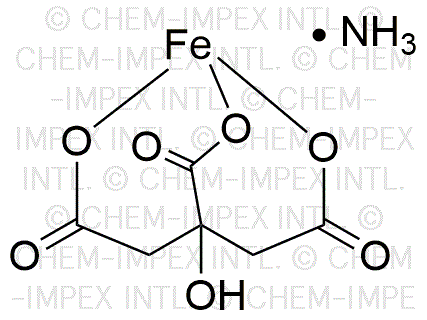Ammonium iron(III) citrate is widely utilized in research focused on:
- Biochemistry: It serves as a source of iron in various biochemical assays, helping researchers study iron metabolism and its role in cellular processes.
- Food Industry: This compound acts as a food additive, enhancing the nutritional profile of products by providing essential iron, particularly in fortified foods.
- Pharmaceuticals: It is used in the formulation of iron supplements, addressing iron deficiency anemia effectively, which is crucial for patient health.
- Environmental Science: Ammonium iron(III) citrate is employed in studies related to soil remediation, aiding in the bioavailability of iron for plants in contaminated soils.
- Cosmetics: The compound is included in some skincare formulations for its antioxidant properties, promoting healthier skin by combating oxidative stress.
General Information
Properties
Safety and Regulations
Applications
Ammonium iron(III) citrate is widely utilized in research focused on:
- Biochemistry: It serves as a source of iron in various biochemical assays, helping researchers study iron metabolism and its role in cellular processes.
- Food Industry: This compound acts as a food additive, enhancing the nutritional profile of products by providing essential iron, particularly in fortified foods.
- Pharmaceuticals: It is used in the formulation of iron supplements, addressing iron deficiency anemia effectively, which is crucial for patient health.
- Environmental Science: Ammonium iron(III) citrate is employed in studies related to soil remediation, aiding in the bioavailability of iron for plants in contaminated soils.
- Cosmetics: The compound is included in some skincare formulations for its antioxidant properties, promoting healthier skin by combating oxidative stress.
Documents
Safety Data Sheets (SDS)
The SDS provides comprehensive safety information on handling, storage, and disposal of the product.
Product Specification (PS)
The PS provides a comprehensive breakdown of the product’s properties, including chemical composition, physical state, purity, and storage requirements. It also details acceptable quality ranges and the product's intended applications.
Certificates of Analysis (COA)
Search for Certificates of Analysis (COA) by entering the products Lot Number. Lot and Batch Numbers can be found on a product’s label following the words ‘Lot’ or ‘Batch’.
*Catalog Number
*Lot Number
Certificates Of Origin (COO)
This COO confirms the country where the product was manufactured, and also details the materials and components used in it and whether it is derived from natural, synthetic, or other specific sources. This certificate may be required for customs, trade, and regulatory compliance.
*Catalog Number
*Lot Number
Safety Data Sheets (SDS)
The SDS provides comprehensive safety information on handling, storage, and disposal of the product.
DownloadProduct Specification (PS)
The PS provides a comprehensive breakdown of the product’s properties, including chemical composition, physical state, purity, and storage requirements. It also details acceptable quality ranges and the product's intended applications.
DownloadCertificates of Analysis (COA)
Search for Certificates of Analysis (COA) by entering the products Lot Number. Lot and Batch Numbers can be found on a product’s label following the words ‘Lot’ or ‘Batch’.
*Catalog Number
*Lot Number
Certificates Of Origin (COO)
This COO confirms the country where the product was manufactured, and also details the materials and components used in it and whether it is derived from natural, synthetic, or other specific sources. This certificate may be required for customs, trade, and regulatory compliance.


